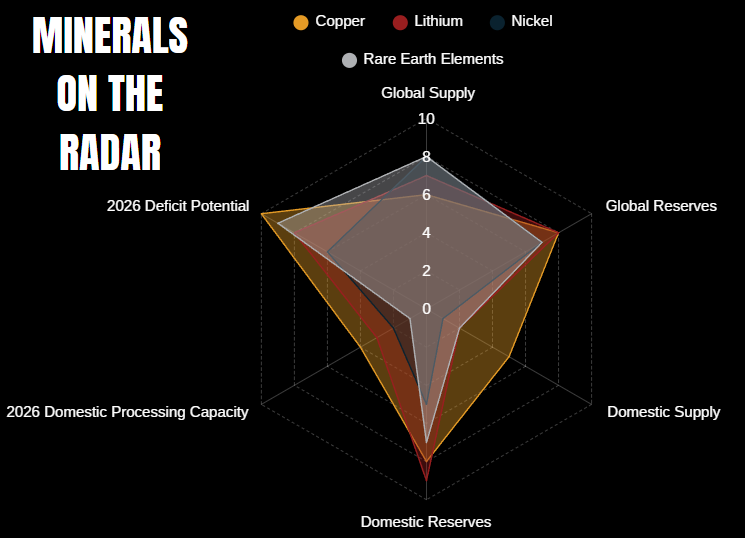New Executive Orders Boosting U.S. Mineral Production: Impacts on Exploration
The Era of Easy Geology is Over.
Discover why 2026 marks the structural shift from Globalism to Sovereign Strategy.
The “flat world” of mining is fracturing. The convergence of the AI arms race, a sovereign debt crisis, and the return of nuclear energy is creating a new industrial reality. In this 16-page outlook, Burgex breaks down the specific opportunities—and existential risks—facing mine developers and investors in the “New Industrial Cold War.”

2026 United States Mining Outlook Report Request
Why You Need This Report:
The market is mispricing the speed of the transition. While headlines focus on “Software” and “Chips,” the real bottleneck is forming in the physical world.
Chart 1: The $600 Billion Hardware Shock

Figure 1: Hyperscaler Capital Expenditure Forecast (2026) Estimated aggregate CapEx for top 5 U.S. technology firms. Data indicates a structural shift in capital allocation toward physical infrastructure (servers, cooling, energy), creating a $602B hardware shock for the supply chain.
The Insight: Tech giants are projected to spend $602 Billion on infrastructure in 2026 alone. This is a capital wave that requires 3x more copper per megawatt than traditional cloud computing. Our report details which specific deposit types will command a “Sovereign Premium” from these buyers.
Chart 2: The 44-Gigawatt Power Cliff

Figure 2: U.S. Data Center Power Demand vs. Firm Supply (2024–2030) The widening gap between projected AI compute demand (Line A) and committed baseload generation (Line B). The shaded red area represents the ~44 GW “Deficit Zone” that requires immediate nuclear or thermal intervention.
The Insight: The U.S. grid faces a 44 GW deficit by 2028—equivalent to 44 nuclear reactors. Our outlook explains why “Power Access” could replace “Grade” as a primary metric for project valuation.
What’s Inside the Report?
Bullet points that promise specific answers to expensive problems.
The Metals Supercycle: Why US debt interest payments (> $1 Trillion/year) have permanently re-rated Gold and Silver as “Counterparty Risk” hedges.
- Critical Minerals: A deep dive into the 2026 supply gaps for Copper, Antimony, and Lithium—and the $4.5 Billion in government funding available to fix them.
The Aggregates “K-Shape”: Why infrastructure megaprojects are booming while the residential stone market freezes—and where to position your quarries.
The “Silicon Valley” Put: How Big Tech’s move into nuclear energy is creating a floor for Uranium prices.
Who Is This For?
Mining Executives: Validate your 2026 strategic planning with independent macro data.
Investors & PE Firms: Identify the “Sovereign Safe Harbors” where capital will flow next.
- U.S. Government Officials: Gain a ground-level perspective on how the shift to resource nationalism and the AI energy crunch are practically reshaping the domestic mining landscape.
Land Managers: Understand how the “AI Land Grab” impacts surface rights and mineral valuation.
Visualizing the Chokepoints
Data Preview from Page 9 of the 2026 Outlook
Chart 3: The Strategic Mineral Radar

Figure 3: Multi-variable assessment of 2026 Supply/Demand dynamics for key critical minerals. Scale 0-10 based on Burgex proprietary weighting.
The Insight: This radar chart reveals the “shape” of the U.S. vulnerability for 2026.
Copper (Orange): Note the massive spike in “Deficit Potential.” It is the most critical immediate shortfall.
Lithium (Red): See the sharp divergence between “Domestic Reserves” (High) and “Domestic Supply” (Low). We have the rocks, but we aren’t mining them yet—a permitting failure, not a geological one.
Rare Earths (Grey): The collapse in “Domestic Processing” visualizes the refining chokepoint that China controls.
Why This Matters: Every shape tells a different investment story. Copper is a “Supply Squeeze” play; Lithium is a “Permitting Arbitrage” play. Our full report breaks down what this means for each commodity profile.
2026 United States Mining Outlook Report Request
About the Authors
Burgex Mining Consultants We are the navigators of the modern supply chain. From Mineralocity market intelligence to feasibility studies, we help clients bridge the gap between geological potential and industrial reality.
